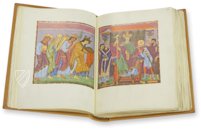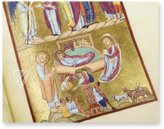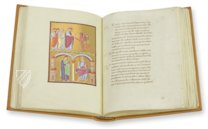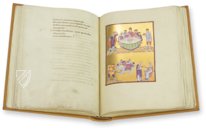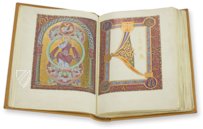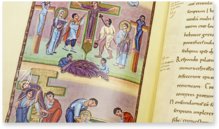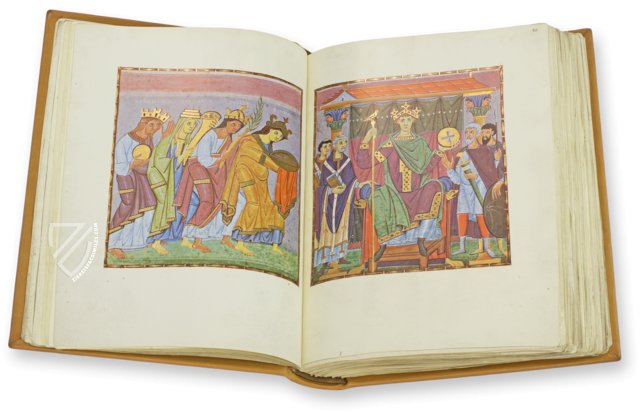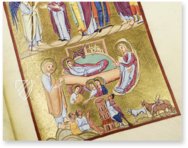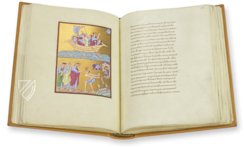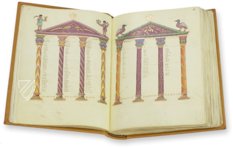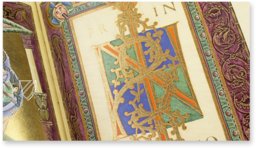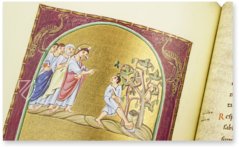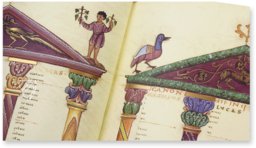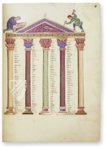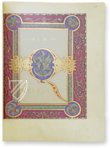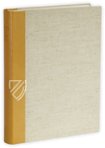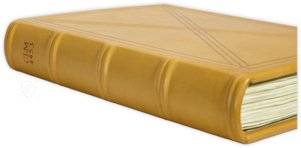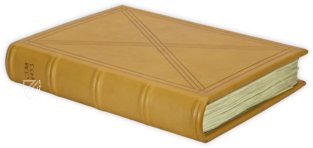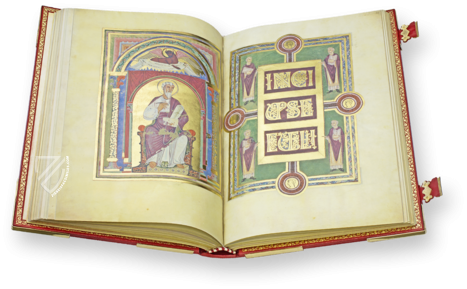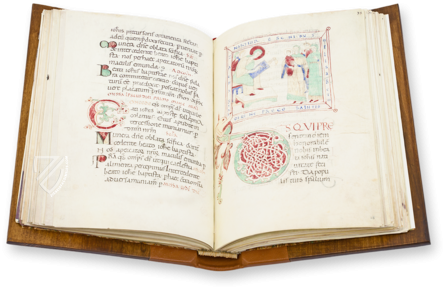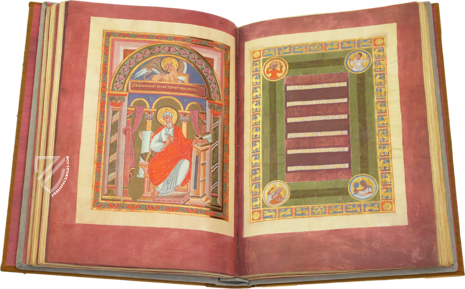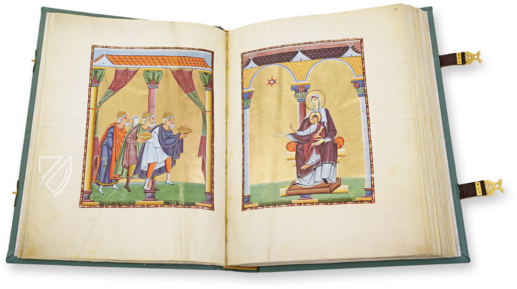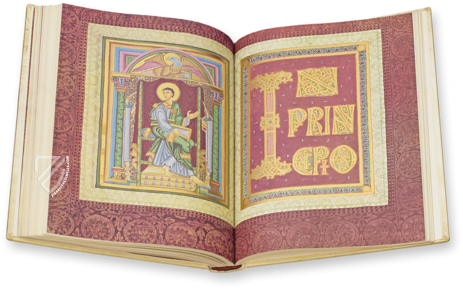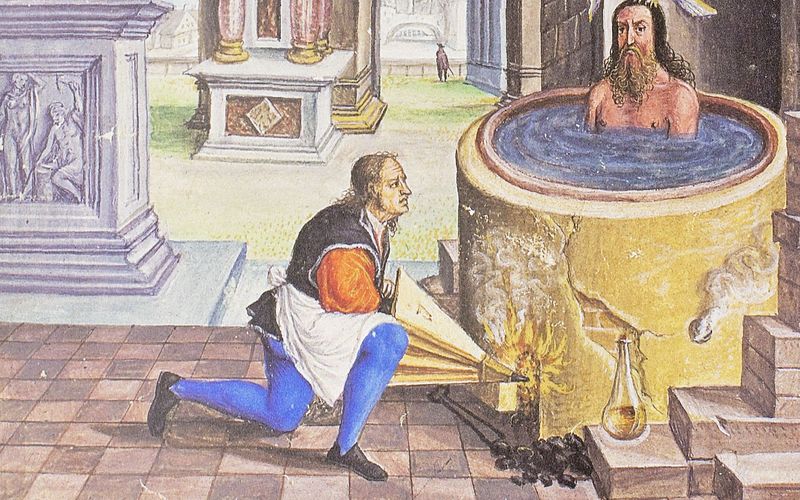Gospels of Otto III
(1,000€ - 3,000€)
A magnum opus of Ottonian illumination: the Gospels of Otto III emerged around the year 1000 as a magnum opus of Ottonian illumination from the influential scriptorium of the Reichenau Monastery on Lake Constance, the center of occidental illumination at that time. The splendid liturgical manuscript was a commission of Emperor Otto III and came into the possession of the Cathedral of Bamberg under his successor, Henry II. Altogether, over 30 full-page miniatures, wonderful canonical tables, and marvelous initial pages present the high quality of the art of the Reichenau Liuthar-school and give a glimpse into the great Ottonian illumination of the late 10th century with their splendid paintings on gold backgrounds.
Gospels of Otto III
The Gospels of Otto III emerged around the year 1000 as a magnum opus of Ottonian illumination from the influential scriptorium of the Reichenau Monastery on Lake Constance, the center of occidental illumination at that time. The splendid liturgical manuscript was a commission of Emperor Otto III and came into the possession of the Cathedral of Bamberg under his successor, Henry II. Altogether, over 30 full-page miniatures, wonderful canonical tables, and marvelous initial pages present the high quality of the art of the Reichenau Liuthar-school and give a glimpse into the great Ottonian illumination of the late 10th century with their splendid paintings on gold backgrounds. This overwhelming splendor is crowned with a precious decorative binding featuring over 188 precious stones and a Byzantine ivory relief. A truly imperial treasure!
A Precious Gold Background for Truly Masterful Achievements
One double-sided and 34 full-page miniatures make up the impressive pictorial adornment of the Gospels of Otto III. Twelve handsome canonical tables are among the total of 552 pages, each with 4 decorative initials. Altogether, they attest to the deep piety and great meaning of the Christian faith for the Kaiser. A pictorial cycle about the life of Christ illustrates the four Gospels. This Passion Cycle presents the latest fashion with its magnificent and high-quality miniatures set against a splendid gold background. The four famous pictures of the Evangelists display furthermore the ground-breaking style of the Liuthar workshop. The gifted illuminators found their stylistic examples in Carolingian as well as Byzantine and Early-Christian book art and furthered these through their own inventions.
A Magnum Opus of Ottonian illumination from the Reichenau Monastery’s Scriptorium
The Pericopes of Henry II, the Bamberg Apocalypse, the Lituthar Gospels in the cathedral treasury in Aachen – all of these names hold special significance in the heart of every lover of early medieval manuscripts. The gorgeous and splendid manuscripts from the scriptorium of the Reichenau monastery are the authoritative artworks of the 10th and 11th centuries. The famous scriptorium of the Reichenau monastery on Lake Constance is considered to be the center of occidental illumination in the 10th and 11th centuries. The illuminators there produced true masterpieces, particularly around the year 1000. The so-called Liuthar workshop was responsible for these treasures of illumination, after which the manuscripts were named the so-called Liuthar-group. One of these highpoints of Ottonian illumination is the exceptional Gospels of Otto III, origination after 997, the heyday of Reichenau illumination.
A Splendid Liturgical Manuscript at the Behest of the Kaiser
Otto III (980–1002) came from the house of the Ottonians and was already King of the Romans as a three-year-old. In the year 996 he was finally made emperor and therewith elected the powerful ruler of the Holy Roman Empire. His reign is characterized in particular through politics that were strongly focused on Italy. The evangeliary named after him attests to the outstanding position of this powerful man, and of his great appreciation of art! After his death, the book came into the possession of Henry II (973 or 978 – 1024). He in turn left the evangeliary to the Bamberg Cathedral, from where it reached the Bavarian State Library in the course of Secularization in 1803. Under the signature ‘Clm 4453’, the Gospels of Otto III represents a highpoint of the collection of precious and important manuscripts.
Codicology
- Alternative Titles
- Gospel Book of Otto III
Evangeliar Ottos III. - Size / Format
- 552 pages / 33.4 × 24.2 cm
- Origin
- Germany
- Date
- Shortly after 997
- Epochs
- Style
- Genre
- Language
- Script
- Carolingian minuscule
- Illustrations
- 1 double-page and 34 full-page miniatures, 12 canon tables, 4 full-page ornate initials
- Content
- The four gospels
- Patron
- Emperor Otto III (reigned A. D. 983–1002)
- Artist / School
- Liuthard workshop
- Previous Owners
- After the death of Otto Ill, the codex was inherited by his successor, King Henry II (reigned 1002–1024), who bequeathed the evangeliary to Bamberg cathedral. After the secularisation of 1803, it went to the Bavarian State Library in Munich
Gospels of Otto III
Roofers at Work
Resting on five columns – two with human faces in their acanthus leaf capitals – this elaborate entablature shows two figures working on the roof of a classical structure. The Gospels of Matthew and Luke are presented side by side to aid the reader in their religious studies – these are the Canon Tables created by Eusebius of Caesarea. This miniature is exemplary of Ottonian illumination from Reichenau’s famous scriptorium and uses only the finest pigments and glimmering gold leaf.

Gospels of Otto III
Patron Portrait of Otto III
This brightly-colored double-page miniature is a masterpiece of Ottonian illumination and a famous representation of the power of the Holy Roman Empire. The artists of Reichenau’s scriptorium drew from Byzantine and Carolingian examples, both of which were firmly rooted in the style of Late Antiquity. Thus, Otto is formidably presented in the purple robes of a Roman emperor.
Otto is enthroned with the imperial crown, orb, and eagle scepter of Augustus. He is flanked by clerics to the left and noble knights to the right. Four figures representing the peoples of the empire – Sclavinia, Germania, Gallia, and Roma – humbly approach with gifts consisting of a shell filled with gems, a palm branch, a cornucopia, and a golden globe.

#1 Evangeliar Ottos III.
Language: German
Transcription, Translation of the Gospels. Format: 35 x 26 cm
(1,000€ - 3,000€)
- Treatises / Secular Books
- Apocalypses / Beatus
- Astronomy / Astrology
- Bestiaries
- Bibles / Gospels
- Chronicles / History / Law
- Geography / Maps
- Saints' Lives
- Islam / Oriental
- Judaism / Hebrew
- Single Leaf Collections
- Leonardo da Vinci
- Literature / Poetry
- Liturgical Manuscripts
- Medicine / Botany / Alchemy
- Music
- Mythology / Prophecies
- Psalters
- Other Religious Books
- Games / Hunting
- Private Devotion Books
- Other Genres
- Afghanistan
- Armenia
- Austria
- Belgium
- Colombia
- Croatia
- Cyprus
- Czech Republic
- Denmark
- Egypt
- Ethiopia
- France
- Germany
- Greece
- Hungary
- India
- Iran
- Iraq
- Israel
- Italy
- Japan
- Lebanon
- Luxembourg
- Mexico
- Morocco
- Netherlands
- Palestine
- Peru
- Poland
- Portugal
- Russia
- Serbia
- Spain
- Sri Lanka
- Sweden
- Switzerland
- Syria
- Turkey
- Ukraine
- United Kingdom
- United States
- Uzbekistan
- Aboca Museum
- Ajuntament de Valencia
- Akademie Verlag
- Akademische Druck- u. Verlagsanstalt (ADEVA)
- Aldo Ausilio Editore - Bottega d’Erasmo
- Alecto Historical Editions
- Alkuin Verlag
- Almqvist & Wiksell
- Amilcare Pizzi
- Andreas & Andreas Verlagsbuchhandlung
- Archa 90
- Archiv Verlag
- Archivi Edizioni
- Arnold Verlag
- ARS
- Ars Magna
- ArtCodex
- AyN Ediciones
- Azimuth Editions
- Badenia Verlag
- Bärenreiter-Verlag
- Belser Verlag
- Belser Verlag / WK Wertkontor
- Benziger Verlag
- Bernardinum Wydawnictwo
- BiblioGemma
- Biblioteca Apostolica Vaticana (Vaticanstadt, Vaticanstadt)
- Bibliotheca Palatina Faksimile Verlag
- Bibliotheca Rara
- Boydell & Brewer
- Bramante Edizioni
- Bredius Genootschap
- Brepols Publishers
- British Library
- C. Weckesser
- Caixa Catalunya
- Canesi
- CAPSA, Ars Scriptoria
- Caratzas Brothers, Publishers
- Carus Verlag
- Casamassima Libri
- Chavane Verlag
- Christian Brandstätter Verlag
- Circulo Cientifico
- Club Bibliófilo Versol
- Club du Livre
- CM Editores
- Collegium Graphicum
- Collezione Apocrifa Da Vinci
- Comissão Nacional para as Comemorações dos Descobrimentos Portugueses
- Coron Verlag
- Corvina
- CTHS
- D. S. Brewer
- Damon
- De Agostini/UTET
- De Nederlandsche Boekhandel
- De Schutter
- Deuschle & Stemmle
- Deutscher Verlag für Kunstwissenschaft
- DIAMM
- Droz
- E. Schreiber Graphische Kunstanstalten
- Ediciones Boreal
- Ediciones Grial
- Ediclube
- Edições Inapa
- Edilan
- Editalia
- Edition Deuschle
- Edition Georg Popp
- Edition Leipzig
- Edition Libri Illustri
- Editiones Reales Sitios S. L.
- Éditions de l'Oiseau Lyre
- Editions Medicina Rara
- Editorial Casariego
- Editorial Mintzoa
- Editrice Antenore
- Editrice Velar
- Edizioni Edison
- Egeria, S.L.
- Eikon Editores
- Electa
- Emery Walker Limited
- Enciclopèdia Catalana
- Eos-Verlag
- Ephesus Publishing
- Ernst Battenberg
- Eugrammia Press
- Extraordinary Editions
- Fackelverlag
- Facsimila Art & Edition
- Facsimile Editions Ltd.
- Facsimilia Art & Edition Ebert KG
- Faksimile Verlag
- Feuermann Verlag
- Folger Shakespeare Library
- Franco Cosimo Panini Editore
- Friedrich Wittig Verlag
- Fundación Hullera Vasco-Leonesa
- G. Braziller
- Gabriele Mazzotta Editore
- Gebr. Mann Verlag
- Gesellschaft für graphische Industrie
- Getty Research Institute
- Giovanni Domenico de Rossi
- Giunti Editore
- Graffiti
- Grafica European Center of Fine Arts
- Guido Pressler
- Guillermo Blazquez
- Gustav Kiepenheuer
- H. N. Abrams
- Harrassowitz
- Helikon
- Hendrickson Publishers
- Henning Oppermann
- Herder Verlag
- Hes & De Graaf Publishers
- Hoepli
- Holbein-Verlag
- Hortus Deliciarum
- Houghton Library
- Hugo Schmidt Verlag
- Idion Verlag
- Il Bulino, edizioni d'arte
- ILte
- Imago
- Insel Verlag
- Instituto Nacional de Antropología e Historia
- Istituto dell'Enciclopedia Italiana - Treccani
- Istituto Ellenico di Studi Bizantini e Postbizantini
- Istituto Geografico De Agostini
- Istituto Poligrafico e Zecca dello Stato
- Italarte Art Establishments
- J. Thorbecke
- Jan Thorbecke Verlag
- Johnson Reprint Corporation
- Josef Stocker
- Josef Stocker-Schmid
- Jugoslavija
- Karl W. Hiersemann
- Kasper Straube
- Kaydeda Ediciones
- Kindler Verlag / Coron Verlag
- Kodansha International Ltd.
- Konrad Kölbl Verlag
- Kurt Wolff Verlag
- La Liberia dello Stato
- La Linea Editrice
- La Meta Editore
- Lambert Schneider
- Landeskreditbank Baden-Württemberg
- Leo S. Olschki
- Les Incunables
- Library of Congress
- Libreria Musicale Italiana
- Lichtdruck
- Lito Immagine Editore
- Lumen Artis
- Lund Humphries
- M. Moleiro Editor
- Maison des Sciences de l'homme et de la société de Poitiers
- Manuscriptum
- Martinus Nijhoff
- Maruzen-Yushodo Co. Ltd.
- MASA
- McGraw-Hill
- Militos
- Millennium Liber
- Müller & Schindler
- Nahar and Steimatzky
- National Library of Wales
- Neri Pozza
- Nova Charta
- Oceanum Verlag
- Odeon
- Orbis Mediaevalis
- Orbis Pictus
- Österreichische Staatsdruckerei
- Oxford University Press
- Pageant Books
- Parzellers Buchverlag
- Patrimonio Ediciones
- Pattloch Verlag
- PIAF
- Pieper Verlag
- Plon-Nourrit et cie
- Prestel Verlag
- Princeton University Press
- Prisma Verlag
- Priuli & Verlucca, editori
- Pro Sport Verlag
- Propyläen Verlag
- Pytheas Books
- Quaternio Verlag Luzern
- Reales Sitios
- Recht-Verlag
- Reichert Verlag
- Reichsdruckerei
- Riehn & Reusch
- Roberto Vattori Editore
- Rosenkilde and Bagger
- Roxburghe Club
- Salerno Editrice
- Sarajevo Svjetlost
- Schöck ArtPrint Kft.
- Scolar Press
- Scrinium
- Scripta Maneant
- Scriptorium
- Siloé, arte y bibliofilia
- SISMEL - Edizioni del Galluzzo
- Sociedad Mexicana de Antropología
- Société des Bibliophiles & Iconophiles de Belgique
- Soncin Publishing
- Sorli Ediciones
- Stainer and Bell
- Studer
- Styria Verlag
- Sumptibus Pragopress
- Szegedi Tudomànyegyetem
- Taberna Libraria
- Tarshish Books
- Taschen
- Tempus Libri
- Testimonio Compañía Editorial
- Thames and Hudson
- The Clear Vue Publishing Partnership Limited
- The Facsimile Codex
- The Folio Society
- The Marquess of Normanby
- The Richard III and Yorkist History Trust
- Tip.Le.Co
- TouchArt
- TREC Publishing House
- TRI Publishing Co.
- Trident Editore
- Typis Regiae Officinae Polygraphicae
- Union Verlag Berlin
- Universidad de Granada
- University of California Press
- University of Chicago Press
- Urs Graf
- Vallecchi
- Van Wijnen
- VCH, Acta Humaniora
- VDI Verlag
- VEB Deutscher Verlag für Musik
- Verlag Anton Pustet / Andreas Verlag
- Verlag Bibliophile Drucke Josef Stocker
- Verlag der Münchner Drucke
- Verlag für Regionalgeschichte
- Verlag Styria
- Vicent Garcia Editores
- W. Turnowsky
- Waanders Printers
- Wiener Mechitharisten-Congregation (Wien, Österreich)
- Wissenschaftliche Buchgesellschaft
- Wydawnictwo Dolnoslaskie
- Xuntanza Editorial
- Zakład Narodowy
- Zollikofer AG




